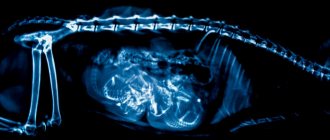4834Pavel
Often, owners of domestic cats associate the word parasite with helminths. In fact, protozoa can cause more serious harm to a cat’s health. The symptoms and treatment of protozoa in cats have been well studied, and we will talk about this today in this article.
Protozoa in cats are represented by unicellular and colonial organisms that lead a parasitic lifestyle in the animal’s body. These protozoa cause diseases that have another name - protozoal infections. The most common of them:
- amoebic dysentery or amoebiasis;
- toxoplasmosis;
- trematodes;
- isosporosis;
- coccidiosis;
- Giardiasis, better known as giardiasis.
© shutterstock
How does protozoa infection occur?
A cat can become infected after eating food or water contaminated with parasite spores. Another route of transmission is the bites of blood-sucking insects. At risk are kittens that still have weak immunity and animals that have recently undergone illness or surgery; they also still have weak immunity. Protozoa in cats are also dangerous for humans. Therefore, when treating pets for protozoa and disinfecting the premises, certain safety rules must be followed. This is especially important if there are children or elderly people in the house. In this case, the sick animal will need to be isolated.
Prevention of protozoa
- Promptly remove feces, disinfect animal care items, and maintain cleanliness in the premises.
- Isolation from stray dogs and cats.
- Do not feed raw meat and offal.
- Avoid eating rodents (in house keeping, a bell on the collar when kept outdoors).
Amoebic dysentery
The amoeba Entamoeba histolytica, entering the cat's body, causes disease. The main symptom is prolonged diarrhea. As a result, inflammation of the colon occurs. People, dogs, cats and some other animals are at risk. Often, a person can be a source of protozoan infection for his pets, even if he himself is not sick, but is only a carrier of these protozoa.
The localization zone of this parasite is the large intestine; in some cases, the disease can be asymptomatic when it enters the chronic stage or with pronounced diarrhea. In the absence of treatment and with incorrectly selected therapy, the cat quickly loses appetite and weight. Stool samples are taken for diagnosis, and antibiotics are often prescribed for treatment.
© shutterstock
Treatment of protozoa
Antiparasitic agents
- Chemical coccide. Effective against any protozoosis. Give orally with food at a dose of 24 mg/kg for 3 days. If necessary, three-day courses are repeated with an interval of 10 days, and for toxoplasmosis, after a 3-day course, they continue to give a dose of 12 mg/kg for another 25 days to prevent re-infection.
- Toltrazuline: drugs Baycox or Stop-coccid. Baycox 5% is given to adult animals at a dose of 10-30 mg/kg for 3 days, which corresponds to 0.2-0.6 ml per 1 kg of weight. Stop-coccid for young animals is recommended at a dose of 10 mg/kg, or 0.2 ml per 1 kg of weight, for 3 days in a row.
Symptomatic therapy
In addition to combating the causative agent of the disease (protozoa), it is necessary to eliminate dehydration and nutritional deficiencies in the body.
- Subcutaneous or intravenous injections of solutions are used: Ringer's, 5% glucose, Refortan, Reamberin.
- In case of severe exhaustion, solutions for parenteral nutrition containing amino acids are indicated - Infezol, Duphalight. Use multivitamins (Hemobalance).
- Astringents and enveloping agents are prescribed internally - flax seed decoction, rice decoction.
- In case of severe damage to the mucous membrane of the digestive tract, sorbents are used - Phosphalugel, Enterosgel, Polypefan.
- If the doctor suspects that a pathogenic microflora caused by damage to the intestinal mucosa has joined the protozoa, an antibiotic or metronidazole (Trichopol) is prescribed.
Diet
- If the cat has previously eaten a commercial diet, special diets are used to maintain the functioning of the gastrointestinal tract: Hill's i/d; Royal Canin GastroIntestinal and others.
- If you are used to homemade food, use liquid slimy rice porridge with boiled beef and fermented milk products.
Feed should be easily digestible and not irritate the digestive tract.
Trematodes
The localization of these protozoa can be in the intestines, liver or pancreas. The route of entry is through an intermediate host, which can be mice, other types of rodents, frogs, which cats like to hunt. Protozoa are usually found in a cat’s feces when it is submitted for diagnosis. The main symptoms include
- nausea;
- vomit;
- loss of appetite;
- weight loss;
- diarrhea;
- lethargic state;
- development of enteritis.
Diagnosis of protozoa in cats
The most common reason to suspect protozoan parasitism is diarrhea that does not respond to antibiotic treatment. Laboratory tests are needed to confirm the diagnosis.
Examination of feces for the presence of oocysts
It is recommended to examine, if possible, fresh feces, then it is possible to distinguish oocysts of different types of protozoa from each other (Toxoplasma, Sarcocyst, Isospora).
A scatological examination (using the Fulleborn or Darling method) is carried out three times, every 2-3 days, since oocysts are not released regularly or in insufficient quantities.
Linked immunosorbent assay
To diagnose giardiasis, there is a rapid test (the answer will be in 5-10 minutes), feces are examined using the ELISA method.
Polymerase chain reaction
The modern method for diagnosing protozoa is PCR. The most sensitive method that detects parasite DNA in a stool sample. It has an accuracy advantage over conventional stool microscopy, but does not give an idea of the intensity of invasion (the number of parasites).
Coccidiosis
Protozoa called coccidia infect the epithelial layer of the intestine. It is extremely difficult to establish a diagnosis, since in most cases there are no symptoms, in the most severe cases diarrhea begins, sometimes mixed with blood, resulting in dehydration and sudden weight loss. Young animals and animals with poor immunity are most susceptible to damage. Poor living conditions for cats also contribute to the spread of the disease. For diagnosis, fecal fragments are examined. For prevention, it is important to follow the rules for keeping cats and feeding them.
Giardia intestinalis (Giardia intestinalis)
Giardiasis is a fairly common protozoal disease. It is promoted by crowded housing and poor feeding, which is why kittens adopted from shelters almost always suffer from it. Adults are practically not affected, but with the slightest decrease in immunity, Giardia begins to intensively damage the intestines. As a result - diarrhea, vomiting, apathetic state and refusal to feed. In kittens, the disease is much more severe; young pets often die from dehydration, intoxication and, in the long term, sepsis.
Please note that giardiasis can be transmitted to people!
In obvious cases of giardiasis, the clinical picture is as follows:
- Intermittent diarrhea . Those. The animal may seem quite healthy and happy with life, but from time to time it suddenly develops profuse and watery diarrhea, and there is mucus in the stool. Feces give off a disgusting smell. Since this rarely happens at first, the owners are not particularly worried: they believe that their pet “ate something wrong.”
- Apathetic state . The animal is indifferent to everything that happens around it, practically not reacting to loud sounds and attempts to play with it.
- Vomit.
- Chronic weight loss. This happens because parasites severely damage the intestines, which then cannot properly absorb nutrients.
- Feces are extremely unpleasant and smell disgusting.
- The cat constantly has flatulence .
If you observe a combination of these clinical signs in your cat, you should immediately take him to the veterinarian. The diagnosis is made on the basis of microscopic analysis of stool and scrapings from the intestinal mucosa.
Lambiasis
With this disease, the small intestine is damaged by protozoan parasites. Infection occurs through consumption of water and food contaminated with Giardia protozoa. A person can also become infected from a cat, so you need to be extremely careful when cleaning the cat's litter box. Symptoms include changes in stool, diarrhea or diarrhea, and sometimes worms are visible in the stool. As we see, protozoan parasites and pathologies in cats are mutually related. And in order to begin proper treatment, you need to conduct an accurate diagnosis of which protozoan caused a specific disease.
Toxoplasmosis
The main, definitive host of the parasite Toxoplasma gondii is a cat, and rodents, farm animals and even humans can be intermediate, which makes the disease especially dangerous.
A person can become infected with toxoplasmosis not only from a cat, but also by eating poorly cooked meat or other contaminated foods. A cat becomes infected by eating the intermediate host of Toxoplasma, most often a mouse. Together with the feces, the parasite's oocysts begin to be released into the external environment. If they are swallowed by an intermediate host, so-called sporozoites emerge from the oocyst, which infect internal organs, actively multiplying in their cells. Tissue cysts are formed, the final stage of development of toxoplasma in the body of the intermediate host.
Toxoplasmosis is reported on all continents. The presence of natural foci and periodic outbreaks of the disease is characteristic. In Russia it is found in St. Petersburg, in the Leningrad region.
From a sick animal, Toxoplasma is isolated everywhere:
- with saliva;
- discharge from the eyes, nose, genitals;
- with urine and feces.
In females, parasites can be excreted in milk, and also penetrate the placenta, infecting the fetuses.
Symptoms of the acute form of toxoplasmosis appear 2-3 days after infection:
- In females - abortion in the first half of pregnancy, the birth of a non-viable litter, kittens with congenital deformities (hydrocephalus, underdevelopment of limbs).
- Increased body temperature to 41 °C, severe trembling and depression (the cat does not eat or drink).
- Conjunctivitis and purulent rhinitis.
- Persistent diarrhea with the release of blood and mucus, vomiting, abdominal pain on palpation.
- Mucous membranes are pale or bluish.
- Tachycardia and rapid breathing.
- Convulsions, paralysis.
The acute form of the disease can lead to death. The chronic course is characterized by exhaustion of the animal, diarrhea, unstable appetite and fever. In cats, toxoplasmosis can occur completely latently, without causing any symptoms.
Babesiosis
The disease is caused by a protozoan called Babesia. The main route of transmission is from ixodid ticks, through their bites. The incubation period usually passes without symptoms. Animals with strong immune systems can survive the disease itself asymptomatically, while cats with weakened immune systems may face death. The main symptoms include darkening of urine, fever, and enlarged lymph nodes. Loss of appetite and, as a result, weight.
© shutterstock
Diseases caused by protozoa
Terms and Definitions
It’s a strange thing: it’s almost impossible to talk about the world of protozoa in a nutshell—you have to write a lot.
Contrary to their name, these microorganisms are very complex, diverse, inexhaustibly interesting, and sometimes unique. Some are deadly.
Previously, we learned about the existence of amoebas and ciliates in school zoology lessons (sometimes immediately forgetting: “I won’t need this in life, I’m going to be a programmer / top model / billionaire / DJ ...”). But lately this topic has somehow come up more and more often - for example, before a business or tourist trip to exotic countries, or in the context of a threat to pregnancy, or as a possible reason for thinness and lack of appetite in a child. We can still, anxiously looking at the clock in eternal time pressure, make hasty vaccinations “against everything” on the eve of departure to the tropics. Or, having learned from the news about another epidemic outbreak here, in your native country and hometown, to the eternal “We came here in large numbers...” irritably add: “... and brought all kinds of infection.”
But it’s not even about migration flows. The world itself has changed, becoming very small, cramped and round. There are no more distances. You have to learn about diseases that not every specialist knew before, and read about the causative agents of these infections, relying on the omnipotence of antibiotics and on your own immunity.
The immunity of Homo Sapiens, although strong, is not absolute; Moreover, we undermine it ourselves, we undermine it at every step, knowing full well what with. This is how our life is, and this is our civilization...
As for antibiotics, their unjustified prescription (by doctors) and amateur use (by patients) has long been a factor that deprives us of our last, perhaps, protection. “Antibiotics, if you take a loading dose, or better yet, two, kill any bacteria today,” this is what some Sapiens think, armed with penicillin and other, more modern and increasingly powerful generations of antibacterial drugs.
But protozoa are not bacteria. With them, everything is not so simple. They are called “protozoa” only in comparison with multicellular organisms, and even then it is not a fact that the latter are better adapted and more promising in terms of survival.
Questions about protozoal infections are becoming "increasingly asked" today. Let's try to understand at least the main points: how protozoa differ from bacteria, viruses and fungi; what diseases they can cause; why these diseases are classified as parasitoses in the group of infectious diseases.
The subkingdom of protozoa includes unicellular eukaryotes, i.e. microorganisms that have one or more cell nuclei. In this they differ from bacteria (prokaryotes, pre-nuclear and non-nuclear unicellular) and from viruses, which are a non-cellular form of organic matter (if we consider packaged clots of ribonucleic molecules as organic matter).
Most protozoa also differ:
- complex multiphase life cycle;
- the ability to reproduce both by asexual division with DNA recombination (like bacteria), and by more advanced, from a genetic point of view, gametogenesis (with the formation of pre-embryonic germ cells-gametes);
- the presence of organelles (pseudopods, flagella, cytostomes, cilia, membranes, etc.);
- heterotrophic nutrition (they can parasitize a macroorganism, absorbing its cells; or they feed on detrital, decaying organic matter, i.e. they lead a saprotrophic lifestyle; or they hunt and devour other microorganisms);
- the ability to both solitary and colonial existence;
- size (this characteristic varies widely among all the smallest, but on average protozoa are thousands of times larger than viruses and an order of magnitude larger than bacteria; some protozoa are visible to the naked eye, reaching several millimeters in size, and some giant multinuclear species grow up to 10-15 cm, remaining at the same time unicellular and meeting all the criteria of the protozoan subkingdom).
Being one of the oldest, primary forms of life (i.e., being part of the group of protist “predecessors”, which also includes lower fungi and algae), protozoan cultures are perfectly adapted in their ecological niche and at their level of biological hierarchy. As you know, evolution goes through all the possibilities and gives every chance to the strongest; the protozoan line chose to remain single-celled, having perfected non-bacterial methods of existence, movement, distribution, feeding, attack and self-preservation not inherent in other microorganisms over two billion years. Very diverse and not too closely related within their strange sub-kingdom, in general protozoa are animals - single-celled, but still animals - and in modern classifications of the earth's biosphere they are classified specifically in the animal kingdom.
There are over 30 thousand species of protozoa in four classes (sarcodaceae, flagellates, sporozoans, ciliates). Almost all of them are neutral in relation to humans. “Almost” – because there are exceptions: both asymptomatic parasitic and clearly pathogenic species are known. They have been studied by humans, of course, much better than other representatives (many of which have not been studied at all), but even here there is still a lot that is unclear. Due to the high adaptability of the pathogen and its ability to metamorphose (some stages of the life cycle are very stable and are specially designed to anabiotically “wait out” unfavorable conditions), protozoal parasitoses are, as a rule, severe and difficult to treat, and sometimes lightning-fast and almost completely lethal. These are, for example, amebic meningoencephalitis, in which the brain matter is corroded and absorbed by the “primitive” amoeba at an exponential rate.
Those who watched the four-part saga about “Aliens” probably still remember the nightmarish, from a human point of view, and in their own way perfect xenomorphs, which were extremely difficult to get rid of. If we reduce these creatures to hundredths of a millimeter and imagine them in the cellular space of living tissue, we will get a good idea of what happens in protozoal diseases. If it seems that the colors are too thick, let us take into account that protozoa kill several million people every year. Several million. Annually. And today this applies not only to distant countries.
Of course, there is no point in falling into dreary, doomed horror. Still, Homo Sapiens is immeasurably more complex (this is its weakness), more inventive and smarter - this is its strength. It is necessary to know, understand, exercise reasonable caution and take adequate measures. Only the most common protozoal parasitoses are listed and very briefly described below. Most of them are also covered in separate articles on the Lakhta Clinic website; Other diseases in this category, if necessary, will be considered in detail in the future.
Routes of transmission of protozoal infections
Let's take a closer look at the methods of transmission of giardiasis. Today, the “classical” and most common are three cases:
- Drinking water contaminated with parasite cysts . This often happens with “rural” cats, who from time to time quench their thirst from roadside puddles.
- It happens that a cat becomes infected simply by sniffing a sick relative. There are a lot of parasite cysts on the fur of sick cats, so there is nothing strange about this.
- Finally, an animal may well become infected simply by licking itself. This happens for the same reason that was stated above.
As we have already said, babesiosis is transmitted by the bites of blood-sucking ixodid ticks, but in practice there are more routes of infection:
- There have been cases of transmission of infection during fights when cats bite each other.
- The intrauterine route of infection is common, when already infected kittens are born to a sick mother.
- In foreign veterinary periodicals you can read that cats became infected through the transfusion of “bad” blood, but this method is not relevant for us.
Finally, we need to tell you how Toxoplasma infection occurs:
- Eating food or drinking water that contains protozoan organisms.
- As in the previous case, intrauterine infection is very likely, since the parasite easily overcomes the placental barrier.
- Blood transfusion. Again, this is not relevant for us.
- A cat may eat an infected mouse, or be bitten by an infected animal during a fight.
- Infection is possible through pork that has not been subjected to heat treatment.
- Finally, flies and other insects can be mechanical vectors of infection. If they have landed on the feces of a sick animal at least once, the parasite will probably remain on the fur of the pet on whose fur the fly sat.











